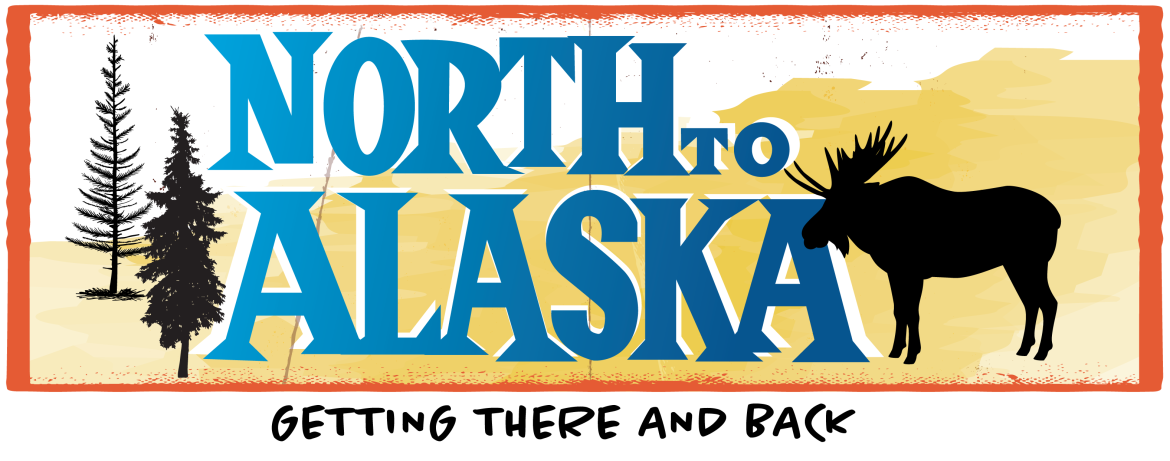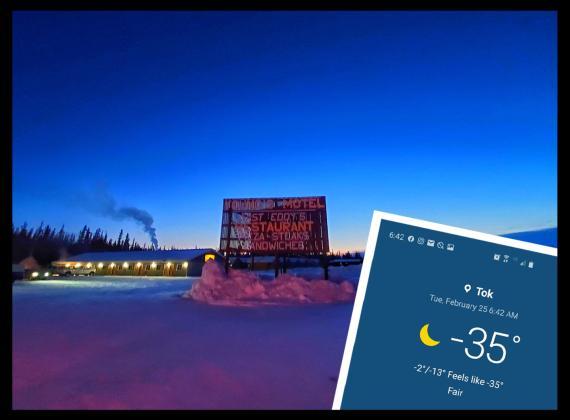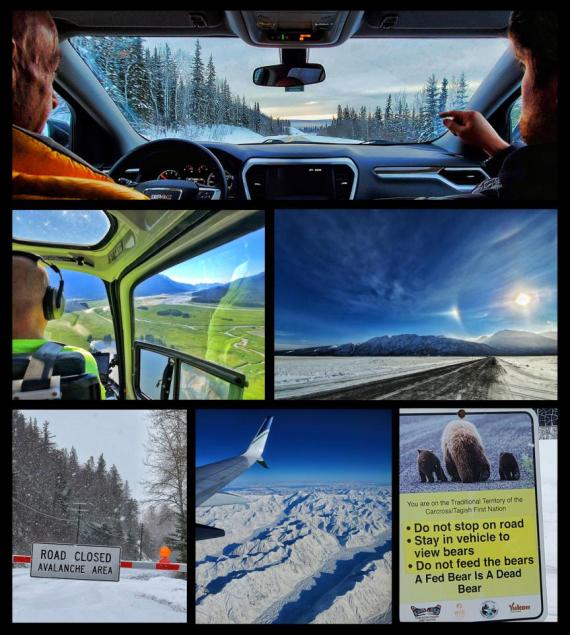Alaska: Getting there and back

Story and photos by: Chad Hutson, Public Affairs Officer
Layout by: Cynthia Henry, Graphic Designer

TOK, Alaska —It’s minus 38°F and the air bites at your lungs when you inhale. Cars and trucks at Young’s Motel are all plugged in. You don’t dare drive in this part of Alaska in February without an engine block heater. Otherwise, you’re going nowhere if the engine sits too long in the bitter cold.
Our Northwest/Arctic Region Building Management Specialist Steve Evans stands in the parking lot of the motel eyeing the fog rising from semi’s idling all night long to keep the diesel fuel in a liquid state.
His gaze turns to the East where he’ll travel the Alaskan Highway into the Canadian Yukon and then back into the United States to meet with a client at the border patrol station at Alcan. He’s got a long journey ahead of him.
The treacherous ice-covered 1,600 miles of road Evans will have to traverse in sub-zero temperatures and sometimes blinding snow to get to his federal clients is, well, just Tuesday.
For most General Services Administration employees, getting to their federal clients to manage buildings requires little more than a short drive across town and sometimes, even across state.
But this is Alaska — 660,000 square miles, much of it frozen during nine months of the year. It covers more area than the entire Eastern Seaboard (14 states). Two states of Texas could fit inside Alaska and it still wouldn’t cover it all.
Evans helps manage leased and owned federal space in the upper Eastern portion of Alaska. Along with his Supervisor, Alaska Field Office Manager Tom Deakins, they’re responsible for managing leased space and federal buildings over an area that is only seven times smaller than the entire U.S. New York is 80 times smaller; California — 24.
“We don’t think twice about it. Up here, it’s just what we have to do to get to our federal partners and take care of them,” Evans said.
They cover a region that puts the Arctic into the region’s name — Northwest/Arctic Region. More than 100 leased and owned spaces are managed by a small team of men and women who, at times, need to know more than just leasing. They are literally working in environments no one else would purposely venture and are oftentimes required to be a jack/jill of all trades, improvising in some of the harshest of weather extremes.
But first they have to get there.
There are four major highways in Alaska. That’s it. By comparison, New York has 31, Alabama 19 and Virginia 20, touching all corners of their respective states. The Alaskan routes are centered around its major cities and towns, leaving tens of thousands of square miles inaccessible by car.

For Deakins, the road trip from Anchorage will cover more than 2,300 miles roundtrip. To put that into perspective, it’s 2,700 from Los Angeles to New York city.
When possible, GSA crews can take a commercial flight, if weather hasn’t already grounded the big jets. Other times they hop on a ferry or take a Bush plane. And each of those come with its own unique challenges.
Taking ferries, particularly from the southern end of the state (Juneau) heading north to Haines and Skagway, the ferry system is not as reliable as one would hope. Rough seas, inclement weather, and even state budget shortfalls halt ferry traffic without much notice. It’s not uncommon to take a ferry only to be stranded in your destination town for days.
And bush planes? Forget the packet of peanuts and beverage service. These planes hold two to six people and require you to wear cold-weather survival suits in the minus-45 degree weather when the plane is being refueled with it’s doors open.
Michelle Jones, Building Management Specialist for Region 10 in Juneau, has tried to rely on both ferries and small bush planes to get to her federal clients.
“I love to fly. But in a seaplane you are literally sitting right behind the pilot and when they start getting nervous about the flying conditions, that can be a little unnerving,” Jones said of her travels around the southeast portion of the state.
And it’s not just the planes that present problems. One trip she brought her car onto the ferry and rough seas stopped ferry service for her return. She had to leave her car and take a seaplane back to Juneau. A colleague later put her car on a ferry for the return trip. It’s not just rough seas that can hinder your return.
A recent trip to Skagway left Deakins and Evans stuck there a few extra days when the road back was closed due to severe avalanche danger. When it opened they reached the top of the pass dotted in signs reminding drivers to keep quiet (to avoid an avalanche from occurring).
When the frozen roads are open, frost heaves (buckling of the roadway from constant freezing and thawing) create a rollercoaster-like ride along the hundreds of miles they travel.
And it’s not just winter when traveling the long distances can be challenging. During the summer longer daylight hours allow for longer drives, however that includes slow-going RV’s and more drivers unfamiliar with the roads and conditions.
Still, neither Deakins nor Evans take these trips lightly regardless of the many times they’ve driven these routes.
“A flat tire out here is life threatening. If something goes wrong things get real out here very quickly,” Deakins said.
That’s why they carry satellite phones (no cell coverage for most of their trip) sleeping bags and cold-weather survival suits. It’s all to perform a job that no other federal agency provides. Not often do people think of anything beyond the task of doing a job. For Alaskans who work for GSA, the journey getting to the job is also unique.
“We’re traveling some of the most sparsely populated places in North America,” Evans added. “We don’t take these trips lightly.”
Read more of the GSA “North to Alaska” series:
Part 1: Getting there and back
Part 2: Alcan Border Station, a city unto its own
Part 3: Getting the customer what they need
Part 4: We’re here - on purpose

 U.S. General Services Administration
U.S. General Services Administration